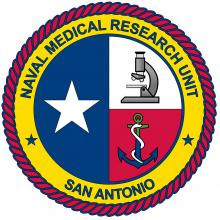Gold nanoparticle-assisted laser therapy for the treatment of bacterial biofilm infections
Multi-drug resistant bacterial infections continue to challenge physicians caring for those injured during combat due to the limited number of effective treatment regimens. Recent studies reveal that fifty-one percent of all bacterial isolates from the largest US combat support hospital in Afghanistan were multi-drug resistant, and methicillin-resistant Staphylococcus aureus (MRSA) accounted for approximately half of the antibiotic resistant strains isolated at combat support hospitals in Iraq. A new treatment strategy being investigated by Navy researchers uses targeted gold nanoparticles (GNPs) to harness pulsed laser energy and eliminate infectious agents. This therapeutic approach could provide an alternative to antibiotics or enhance the efficacy of traditional treatment regimens.
In the early stages of this project, a novel system was developed to alllow researchers to more easily examine the efficacy of laser treatment regimens, while minimizing the risk of human error and reducing the number of man-hours required to process samples. In addition, the automated system can easily be tailored for use in other experiments requiring any or all of the constituent sub-components that control the laser exposure, measure the delivered laser energy, and physically position samples to align with the laser path, and thus has the ability to support future research projects that will benefit the warfighter.
Previous work on this project has also demonstrated the effectiveness of using GNP-enhanced laser therapy to kill bacteria cells in planktonic culture. The current research will evaluate the use of laser therapy as a potential alternative strategy to physically destroy and disperse bacterial biofilms and cells using a MRSA infection model.
Along with conventional multi-drug resistant mechanisms, the formation of bacterial biofilms poses a significant hindrance to the treatment of wound infections. Biofilms can be thought of as bacterial cities, with a sugary coating that protects the bacteria from antibiotics and the immune system, similar to a wall garnering protection to a city. An alternative way to counteract these antibiotic resistant bacteria and biofilms is with physical therapies like heat, light, and sound waves; where antibiotic resistance is overcome, the bacterial biofilm wall can be damaged, and worries of mechanical resistances are unlikely.
To date, the Navy researchers have successfully shown that treatment of MRSA biofilms with a combination of GNPs at 70 µg/mL followed by pulsed laser therapy led to significant bacterial cell killing, with a 89% reduction in viability. The treatment also led to 96% dispersion of biofilms as evidenced by confocal microscopy. In contrast, biofilms and cells in the untreated control remained robust and viable. Likewise, biofilms treated with laser or GNPs alone remained unaffected and comparable to the untreated controls.
These results demonstrate the use of gold nanoparticle-assisted laser therapy as a potential strategy to physically destroy and debride biofilms and cells from a wound site, and thus eradicate a protective and obstructive barrier. Subsequent efforts will demonstrate the ability of GNP-assisted laser therapy to improve the effectiveness of antibiotics against the biofilms.
During the course of this project Navy researchers will optimize a strategy for GNP targeting to biofilms, assess potential toxicity of targeted GNP formulations on host cells, and demonstrate efficacy of GNP-assisted laser therapy at clinically-relevant near-infrared laser wavelengths.
Laser-induced opto-acoustic treatment of bacterial biofilm infections could prove effective at eradicating pathogens, regardless of their level of antibiotic resistance. If successful, this new treatment regime will give health care providers an alternative, non-pharmaceutical approach to treating combat wounds.
Selected Publications
Glickman R. D., Millenbaugh, N. J., Kirui D. K., Maswadi, S., Thomas, R. J., Oian, C. A. (2016). Enhancement of pathogen detection and therapy with laser-activated functionalized gold nanoparticles. In A. H. Grumezesch (Ed.), Nanobiomaterials in Antimicrobial Therapy: Applications of Nanobiomaterials, Volume 6 (pp.229-260). http://dx.doi.org/10.1016/B978-0-323-42864-4.00007-5
Waters, C. M., Burton, T., Kirui, D. K., Millenbaugh, N.J. (2016). Enzymatic degradation of in vitro Staphylococcus aureus biofilms supplemented with human plasma. Infection and Drug Resistance, 2016:9, 71-78. http://dx.doi.org/10.2147/IDR.S103101
Millenbaugh N. J., Baskin J. B., DeSilva, M. N., Elliott, W. R., Glickman, R. D. (2015). Photothermal killing of Staphylococcus aureus using antibody-targeted gold nanoparticles. International Journal of Nanomedicine, 2015:10, 1953-1960. http://dx.doi.org/10.2147/IJN.S76150

